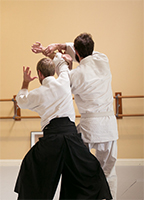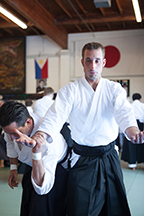O’Sensei once said that a student could learn all the basics of aikido if he practiced just three techniques: 1)tai-no-henko, 2)morotedori-kokyuho, and 3)suwariwaza-kokyuho. Given the seemingly endless number of different waza and their variations, how is it possible to encompass aikido in just these three primary techniques?
Morihiro Saito-Sensei begins his “Takemusu Aikido” (Vol. I) instruction book with these same three techniques. There is something special happening here. Takemusu Aikido Association dojos, following in the tradition of Morhiro Saito-Sensei, incorporate these three techniques into every day of training. Every taijutsu class in Traditional Aikido of Sonoma dojos (Sebastopol, Petaluma, Rohnert Park) includes time spent on these three techniques. Through these three techniques it is possible to unlock deeper principles contained within Takemusu Aikido.
These three principles of aikido are kokyu-ryoku, tai-no-sabaki, and ki-no-musubi. Each of these principles is used to properly train and execute every aikido technique. Kokyu-ryoku is your extension, your breath, your ki. O’Sensei called extension the “circle of steel”. It can also be thought of as your sphere. Literally, kokyu-ryoku means “breath power”, or learning to coordinate breath with movement. When you understand when to breathe in, when to breathe out, then aikido becomes a moving meditation.
Tai-no-sabaki is “body movement”. But it means more than just stepping here or there. Tai-no-sabaki has kokyu-ryoku integrated into it, so that when you step, slide, or pivot, you always have your breath, extension, sphere. Without kokyu-ryoku in tai-no-sabaki, you are only walking around.
Students who have practiced both aikido and t’ai-chi have said they find many similarities between the two arts. To someone who has not practiced either one of these, this may seem a confusing statement. For an advanced aikido student, techniques are executed quickly, in a blur. T’ai-chi, on the other hand, appears quite slow and deliberate. But the coordination of breath with movement, the sinking of your center, the sphere, are the same in both.
Finally, ki-no-musubi literally means “knotting or tying up ki”. This principle is closely tied to the concept of setsuzoku, or “connection”. It is the act of merging with uke’s movements at the very instant they appear. As every person is different, so is every ki. You must adapt. Ki-no-musubi is tying up your ki with that of your partner’s, so that when he moves, you move. Setsuzoku must be present, otherwise you cannot merge your ki with your partner’s. If your mind wanders, or is clogged with the affairs of the day, proper ki-no-musubi cannot be executed.
Looking at the three basic aikido symbols can give us a hint: the triangle, circle, and square relate to the above principles in deeper ways. It has been said that the triangle is the body; the circle is the movement; and the square is the harmony that is created by ai-ei-ki, or two triangles together.
So how does all this relate to the Three Techniques That Have Everything? While there are countless techniques a student can practice, tai-no-henko, morotedori-kokyuho, and suwariwaza-kokyuho have a purity about them that belies their simplicity.
Even though other techniques use all three principles mentioned above, these three techniques do so without clutter. The turning in tai-no-henko is that most basic movement we use in so many other techniques. Maintaining good setsuzoku, connection, in morotedori-kokyuho is very challenging, yet it provides the basis for understanding connection and merging with your partner in all other techniques. A strong person can always out-muscle a weaker person in a “wrestling match”, but if suwariwaza-kokyuho is done properly—if breath power, body movement, and merging are present—then a 100 pound nage can topple a 250 pound uke every time.
You may like to think of these three techniques as a sort of carpenter’s toolkit: what you use them to build, and the quality of your construction, will define the excellence of the sphere inside which your aikido practice takes place.


